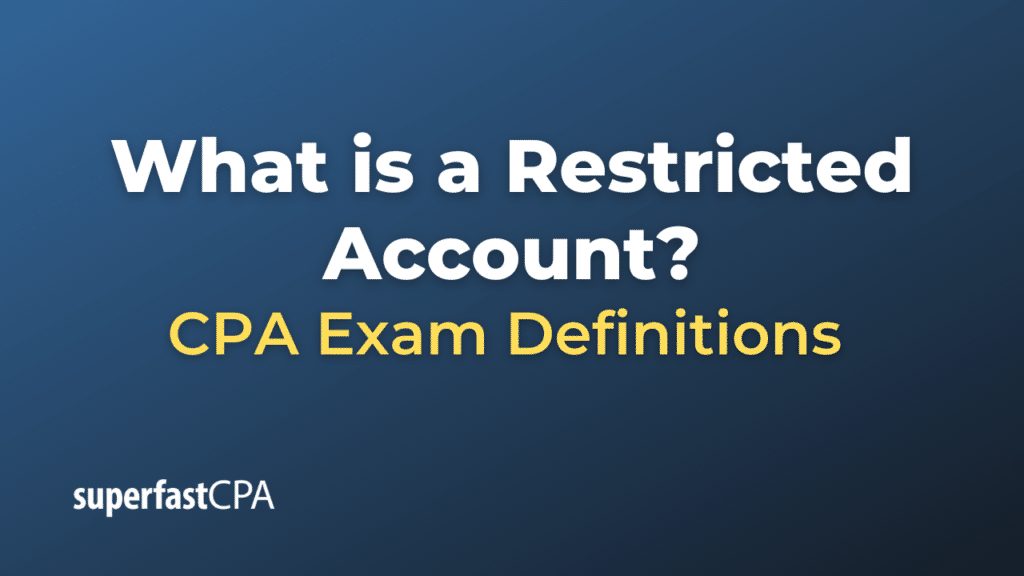Restricted Account
A restricted account typically refers to an account that has certain limitations or restrictions placed upon it. These limitations could be imposed by an external party, like a regulatory body, or could be self-imposed by the account holder for specific purposes. The nature and purpose of the restrictions can vary widely, but they typically limit the ability to access or use the funds in the account.
Here are some common examples and contexts where restricted accounts might be found:
- Investment Brokerage Accounts: Some investment accounts may have restrictions on the sale of recently purchased securities. For instance, in the U.S., there’s the concept of a “restricted period” for securities under Regulation T, which dictates that securities bought must be fully paid for before they can be sold.
- Trust Funds: Trust accounts often come with restrictions detailing when and how the funds can be accessed or used, usually specified by the person who set up the trust.
- Bank Accounts: Some bank accounts, especially in business contexts, might have withdrawal restrictions to ensure that certain funds are only used for specific purposes.
- Endowments and Donations: When institutions, like universities or non-profits, receive endowments or large donations, these funds might be placed in a restricted account. The donor might specify that the principal amount remains untouched and only the interest or earnings can be used, or they might specify the funds to be used only for a particular purpose, such as scholarship grants or research in a specific field.
- Retirement Accounts: Accounts like IRAs or 401(k)s in the U.S. come with certain restrictions. For instance, there might be penalties for withdrawing funds before a certain age.
- Legal or Regulatory Restrictions: Sometimes, due to legal battles or regulatory compliance, certain assets or accounts of an individual or entity might be frozen or restricted.
- Savings Accounts with Withdrawal Limits: Some savings accounts are set up to encourage saving habits and may restrict the number of withdrawals one can make within a certain period.
It’s crucial for account holders to be aware of any restrictions on their accounts, as violations might result in penalties, additional costs, or legal repercussions.
Example of a Restricted Account
Let’s delve into an example involving a university’s endowment fund to illustrate the concept of a restricted account.
University: Prestige University
Endowment Fund: Prestige Scholarship Fund
Background: An alumnus of Prestige University, Mr. John Thompson, donates $5 million to his alma mater with the intention of funding scholarships for deserving students. Instead of using the entire donation all at once, the university decides to place the amount in an endowment, ensuring that the principal remains untouched, and only the generated interest or returns are used for the scholarships.
Setting Up the Restricted Account:
Prestige University sets up the “Prestige Scholarship Fund” account, which is a restricted account. The restrictions are:
- Principal Preservation: The original $5 million donated by Mr. Thompson cannot be spent. It must remain intact.
- Usage of Returns : Any interest, dividends, or capital gains generated from investing the $5 million can be used exclusively for student scholarships. Suppose the investments from the principal amount generate a return of 4% in the first year. This means $200,000 (4% of $5 million) can be utilized for scholarships for that year.
- Reinvestment: Any unused returns in a given year can be reinvested, contributing to the principal amount, which can then generate more returns in subsequent years.
Scenario:
In Year 1, the fund generates a return of $200,000. The university awards $180,000 in scholarships to deserving students. The remaining $20,000 gets reinvested, making the new principal $5.02 million.
In Year 2, with a similar 4% return on the increased principal, the fund generates $200,800. This amount is then available for the next batch of scholarships.
This example showcases the idea of a restricted account where the original sum (principal) is preserved, ensuring longevity for the scholarship program. Such accounts are vital for many institutions, allowing them to manage funds responsibly while adhering to the wishes of donors or the stipulated guidelines of the account.













